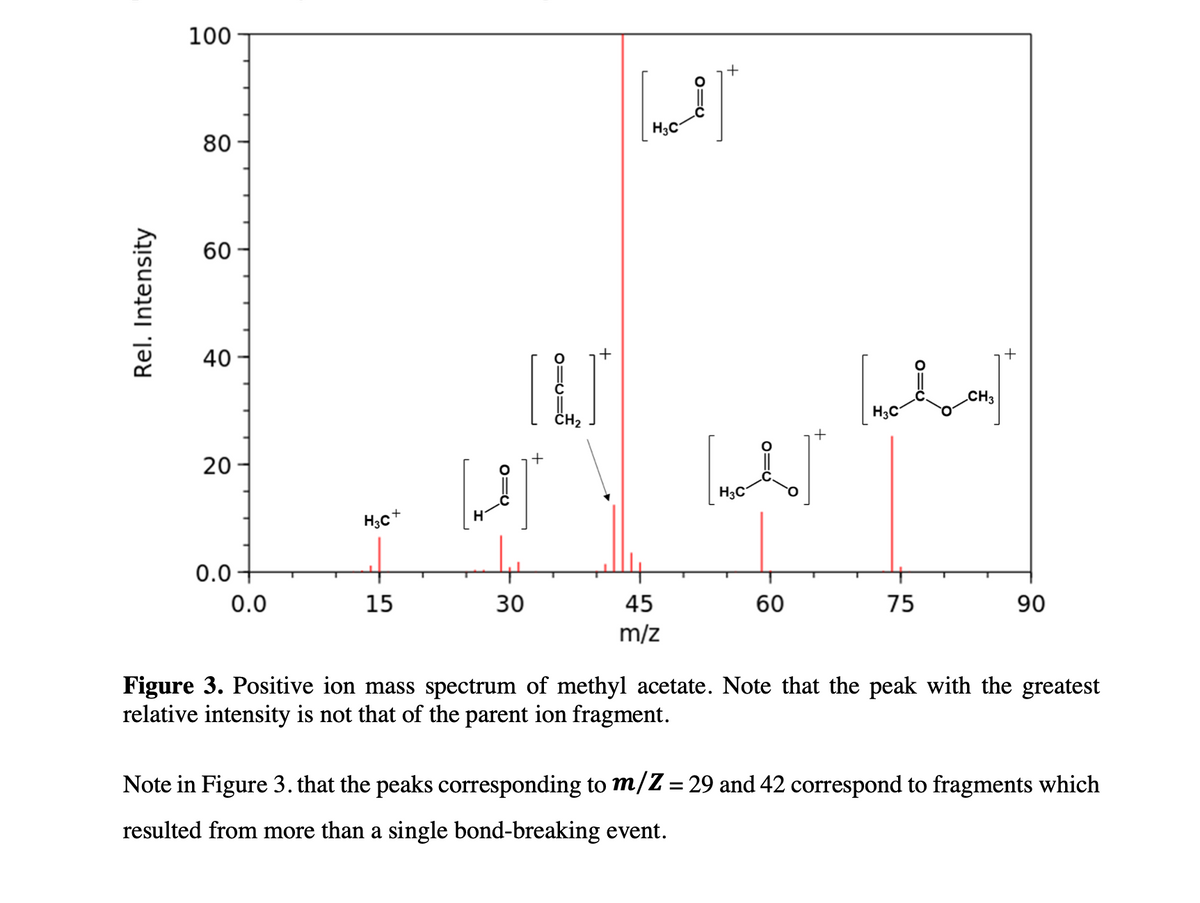100 H3C 80 60 40 CH3 H3C 20 H3C H;c+ 0.0- 0.0 15 30 45 60 75 90 m/z Figure 3. Positive ion mass spectrum of methyl acetate. Note that the peak with the greatest relative intensity is not that of the parent ion fragment. Note in Figure 3. that the peaks corresponding to m/Z = 29 and 42 correspond to fragments which resulted from more than a single bond-breaking event. Rel. Intensity
100 H3C 80 60 40 CH3 H3C 20 H3C H;c+ 0.0- 0.0 15 30 45 60 75 90 m/z Figure 3. Positive ion mass spectrum of methyl acetate. Note that the peak with the greatest relative intensity is not that of the parent ion fragment. Note in Figure 3. that the peaks corresponding to m/Z = 29 and 42 correspond to fragments which resulted from more than a single bond-breaking event. Rel. Intensity
Principles of Instrumental Analysis
7th Edition
ISBN:9781305577213
Author:Douglas A. Skoog, F. James Holler, Stanley R. Crouch
Publisher:Douglas A. Skoog, F. James Holler, Stanley R. Crouch
Chapter20: Molecular Mass Spectrometry
Section: Chapter Questions
Problem 20.9QAP
Related questions
Question
A low-intensity peak at ?/? = 31 can be seen in the mass spectrum of methyl acetate in Figure 3. Propose a fragment that could originate from methyl acetate and be responsible for this peak.

Transcribed Image Text:100
+
H3C
80
60
[LJ
40
+
CH3
H3C
+
20
H3C
H;c+
0.0+
0.0
15
30
45
60
75
90
m/z
Figure 3. Positive ion mass spectrum of methyl acetate. Note that the peak with the greatest
relative intensity is not that of the parent ion fragment.
Note in Figure 3. that the peaks corresponding to m/Z = 29 and 42 correspond to fragments which
resulted from more than a single bond-breaking event.
Rel. Intensity
o=U
Expert Solution
This question has been solved!
Explore an expertly crafted, step-by-step solution for a thorough understanding of key concepts.
This is a popular solution!
Trending now
This is a popular solution!
Step by step
Solved in 2 steps with 1 images

Knowledge Booster
Learn more about
Need a deep-dive on the concept behind this application? Look no further. Learn more about this topic, chemistry and related others by exploring similar questions and additional content below.Recommended textbooks for you

Principles of Instrumental Analysis
Chemistry
ISBN:
9781305577213
Author:
Douglas A. Skoog, F. James Holler, Stanley R. Crouch
Publisher:
Cengage Learning

Organic Chemistry
Chemistry
ISBN:
9781305580350
Author:
William H. Brown, Brent L. Iverson, Eric Anslyn, Christopher S. Foote
Publisher:
Cengage Learning


Principles of Instrumental Analysis
Chemistry
ISBN:
9781305577213
Author:
Douglas A. Skoog, F. James Holler, Stanley R. Crouch
Publisher:
Cengage Learning

Organic Chemistry
Chemistry
ISBN:
9781305580350
Author:
William H. Brown, Brent L. Iverson, Eric Anslyn, Christopher S. Foote
Publisher:
Cengage Learning


Macroscale and Microscale Organic Experiments
Chemistry
ISBN:
9781305577190
Author:
Kenneth L. Williamson, Katherine M. Masters
Publisher:
Brooks Cole